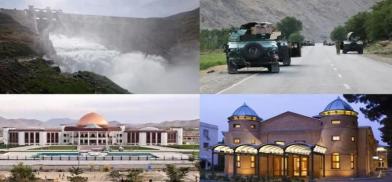Why despite few returns India remains invested in Afghanistan
A few months back the members of the Taliban regime in Kabul attended a four-day ‘India immersion’ online course offered by the Ministry of External Affairs through IIM Kozhikode. The course was part of the capacity-building assistance through the ITEC (Indian Technical and Economic Cooperation) programme to developing countries, including Afghanistan.

Afghanistan has always been characterized as a violent, conflict-prone and unstable region of South Asia —order and stability are provisional and the regimes are frequently overturned. The presence of international forces and a democratically elected government for 20 years since 2001 had given some hope of stability and peace in Afghanistan. However, the events leading to August 14, 2021 crushed all the hopes that the country is going to be a stable nation. Afghanistan was going the way it had been for decades. Has it, however, changed for India or in any way impacted Indian foreign policy?
The collapse of the Afghan National Force sealed the fate of the Afghan government and paved the way for the return of the Taliban. In fact, the swift breakdown of the Afghan National Defense and Security Forces (ANDSF) resistance raises many questions about their capability and capacity to hold back insurgents without the technical and military support of the US forces. During the September 1996 onslaught on Kabul, the Taliban were able to gain some foothold north of Kabul, but within two weeks were pushed back by the counterattack of the combined forces of Masood and Dostam. The combined forces launched a counter-attack and retook strategic places such as Jabal-os-Siraj, Bagram and Charikar and moved to within rocket range of Kabul. By the end of 1996, the conflict had reached a stalemate.
During the Taliban rule between 1996-2001, India and her strategic interests in the region were totally sidelined by the Taliban government. The destruction of statues and artefacts of Buddha at Bamiyan in Afghanistan, the landing of the IC 814 hijacked plane in Kandahar and the tormenting follow-up events, was the manifestation of the ideological orientation of the Taliban, their close linkage with Pakistan. Needless to say, their views on Kashmir and support for fundamental organisations was something that was unfavourable to India. There were credible reports during this period that clearly proved that the Taliban were handing over terrorist training facilities to the Harkat-ul-Ansar, a terrorist organisation working on the behest of Pakistan against India.
India had officially backed the Rabbani government in Afghanistan, despite the fall of Kabul to the Taliban. She, had covertly, if not openly supported the opposing forces, including providing military and medical assistance to the Northern Alliance led by Ahmad Shah Massoud. The Taliban to India and vice versa India to Taliban was a pariah state.
India and the Taliban
Since the withdrawal of the international forces and the fall of the Afghan government, the first two years of Taliban rule is marked by a phase of uncertainty, with deep economic and humanitarian crises gripping the country. The government in Kabul has been constantly asking for international support, including from India. Since the Taliban have come to power in Afghanistan in August 2020, it has been sending an inconsistent message on the Kashmir issues, has welcomed India’s humanitarian assistance during the period, and has also invited India to invest in Afghanistan. This has come, despite the fact that India has not recognised the Taliban government at the centre; however, at the same time, India has remained silent on whom it considers the legitimate government. A policy in contradiction to its stand during the 1996-2001 period.
Apart from it, there are two things that have not changed in the last 3 decades— India’s insistence on unity, independence, sovereignty and territorial integrity of Afghanistan. A call for peaceful negotiations among Afghan parties and the need for an end to all foreign interference. Secondly, India’s humanitarian approach to her foreign policy towards Afghanistan.
During the 1996-2001 period of the Taliban regime, India had been involved in humanitarian assistance missions in Afghanistan. After the devastating earthquake in Afghanistan on May 30, 1998, India continued to send humanitarian assistance to Afghanistan. In 1999, when thousands of Afghan people were displaced from the Shumali plains and Takhar province, tents, blankets, tonnes of food items and tonnes of medicines, medical supplies and medical equipment were dispatched by chartered flights. The outreach was taking place through the UN even when the Taliban were able to force President Rabbani and Commander Masood with their forces to retreat from Kabul.
For decades, India’s primary tool of engagement with Afghanistan has been humanitarian diplomacy either bilaterally or through the UN. In the absence of formal diplomatic outreach through embassies and government-to-government relations, India has fallen back on humanitarian diplomacy when it comes to dealing with Afghanistan. India's cooperation with Afghanistan has consistently focussed on areas which are of direct benefit to the Afghan people.
Humanitarian and developmental assistance
Since 2001, apart from humanitarian diplomacy, she has invested in extensive and wide-ranging financial aid and assistance, undertaking projects related to infrastructure development as well as building human capital. US presence in Afghanistan was the overarching security umbrella under which India’s multiple developmental activities, economic assistance, capacity building and technical assistance projects fructified. India’s humanitarian diplomacy had given it space to engage with the masses of Afghanistan. She had been able to embed its pro-people assistance programmes and economic assistance policy to the larger traditional official diplomacy tools, and over the years the two appear to be part of one broad Indian foreign policy approach. This approach also helped it gain the goodwill of the masses as well as the powerful provincial political leaders, particularly those who were wary of Pakistan's involvement in the region.
A few months back the members of the Taliban regime in Kabul attended a four-day ‘India immersion’ online course offered by the Ministry of External Affairs through IIM Kozhikode. The course was part of the capacity-building assistance through the ITEC (Indian Technical and Economic Cooperation) programme to developing countries, including Afghanistan.
Earlier, India had supplied through international organisations 50,000 MT of wheat to the people of Afghanistan. The wheat assistance was delivered in multiple consignments. Similarly, India supplied 500,000 doses of COVAXIN, 13 tons of essential lifesaving medicines and 500 units of winter clothing to Afghanistan in 2022.
In its Union Budget 2023-24, India has allocated 200 crore INR (about 25 million USD) to the Ministry of External Affairs for expenditure on grants and loans to Afghanistan. The amount remains unchanged from the last year, and yet shows India’s willingness to continue with its policy.
India knows there is a limitation to humanitarian diplomacy in a country where the regime has subdued the democratic ethos of the masses and has a very centralized form of governance. Consequentially, there are few political returns to the assistance provided by India when the outcome is severely manipulated. Still, the emerging contours of the Afghan security environment have monumental implications for India’s own strategic and security environment. Therefore, India despite having reservations about the Taliban’s highly exclusionary and repressive governance model has not many options but to engage with it.
(The author is a Project Leader, Centre for Military History and Conflict Studies, United Service Institution of India. Views are personal. He can be contacted at gauravdixit04@gmail.com)










Post a Comment